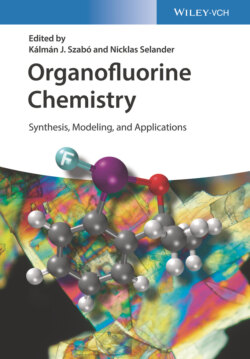Читать книгу Organofluorine Chemistry - Группа авторов - Страница 12
1.2.3 The “Negative Fluorine Effect” Facilitates the α‐Elimination of Fluorocarbanions to Generate Difluorocarbene Species
ОглавлениеBased on the results described in Sections 1.2.1 and 1.2.2, we were able to achieve gem‐difluoroolefination of diazo compounds under transition metal‐free conditions via direct cross‐coupling between a non‐fluorinated carbene precursor from a diazo compound and difluorocarbene from TMSCF3 or TMSCF2Br (Scheme 1.3a) [16]. This reaction proceeds through nucleophilic addition of diazo compounds to difluorocarbene, followed by β‐N2 elimination from intermediate 3, to form gem‐difluoroolefins. The most significant feature of this protocol is the broad substrate scope (compared with our previous copper‐catalyzed method of diazo compounds, which is only efficient for diaryl diazomethanes). α‐Diazo acetates, diaryl diazomethanes, as well as diazirines are all suitable substrates. Moreover, by simply tuning the molar ratio of diazirines and TMSCF2Br, either gem‐difluoroolefins or tetrafluoropropanes can be obtained selectively (Scheme 1.3b). It should be noted that the in situ generation of difluorocarbene occurs via an α‐elimination of fluoride ion from “CF3−” (in the case of TMSCF3), or via an α‐elimination of bromide ion from “CF2Br−” (in the case of TMSCF2Br), which can be explained by the “negative fluorine effect (NFE),” that is, fluorine substitution on a carbanionic center will often have a negative (unfavorable) effect on the carbanion's thermal stability and its nucleophilic reactions with many electrophiles.
Scheme 1.3 Transition metal‐free gem‐difluoroolefination of diazo compounds.
Alkylsilane reagents are useful in cross‐coupling reactions. In the presence of a Lewis base, alkylsilane can act as “R−” donor to undergo alkylation under transition metal catalysis [17]. In this context, fluoroalkylsilanes often serve as nucleophilic fluoroalkylation agents. For instance, (trifluoromethyl)trimethylsilane (TMSCF3) has been recognized as an efficient “CF3−” donor since 1989 [18] and has been studied extensively ever since [19]. However, because of the fluorine substitution, TMSCF3 is not merely a “CF3−” equivalent. In 2011, our group, in collaboration with the Prakash group, found that TMSCF3 is also an efficient difluorocarbene precursor [8d]. By employing nonmetallic fluoride TBAT (tetrabutylammonium triphenyldifluorosilicate) as an initiator at low temperature (−50 °C to r.t.) or NaI as a promoter at higher temperature (65 or 110 °C), efficient synthesis of gem‐difluorocyclopropa(e)nes can be achieved with TMSCF3 (Scheme 1.4).
Scheme 1.4 TMSCF3 as a difluorocarbene precursor for gem‐difluorocyclopropa(e)nation.
Difluorocarbene species derived from TMSCF3 can dimerize to form tetrafluoroethylene (TFE) in an efficient and mild manner, providing a convenient and safe protocol for the generation and handling of TFE in academic laboratories (Scheme 1.5a) [20]. Previously, TFE was normally inaccessible for common laboratories due to its suspected carcinogenic and explosive nature. The application of on‐site prepared TFE was demonstrated by the pentafluoroethylation and aryloxytetrafluoroethylation of aryl iodides and 1, 1,2, 2‐tetrafluoroethylation of phenols, alcohols, thiophenols, and heterocyclic amines (Scheme 1.5b–d).
More recently, we also accomplished fluorocarbon chain elongation process with TMSCF3 as a difluorocarbene source. Selective one‐carbon elongation from trifluoromethyl to pentafluoroethyl [21], and two‐carbon elongation from pentafluorophenyl to perfluorophenylethyl [22] were efficiently realized under copper‐mediated conditions, providing a non‐TFE pathway (Scheme 1.6). The key issue of this process is harnessing “CuCF3” as a copper difluorocarbene (“Cu=CF2”) equivalent.
TMSCF2Br was developed by us as a privileged difluorocarbene reagent, which has been used to difluoromethylate a plethora of O‐, S‐, N‐, P‐, and C‐nucleophiles as well as to cyclopropa(e)nate alkenes or alkynes [8e, f (Scheme 1.7). Because of the much better leaving ability of Br− than F−, the life time of BrCF2− is short enough that it readily eliminates Br− to produce difluorocarbene even in the presence of large amount of water or acid. TMSCF2Br can generate difluorocarbene under a wide range of conditions, ranging from strongly basic to weakly acidic, from aqueous to anhydrous, and from low temperatures to high temperatures [8e, f, 23, 24]. This unique feature renders TMSCF2Br particularly versatile and makes its orthogonal reactions with ambident substrates possible [23] (Scheme 1.8).
Scheme 1.5 TMSCF3 as tetrafluoroethylene precursor.
Scheme 1.6 TMSCF3 for fluorocarbon elongation.
Scheme 1.7 The application of TMSCF2Br as a difluorocarbene reagent.
Scheme 1.8 Orthogonal reactivity of TMSCF2Br with ambident substrates.
Let us take alkene‐ester substrate 11 (see Scheme 1.8c) as an example to showcase the unusual orthogonal reactivity of TMSCF2Br with different functional groups: in the presence of KOtBu, the C—H bond α to the ester group could undergo deprotonation to generate the corresponding nucleophilic carbanion, which is highly reactive toward difluorocarbene, while the alkene group shows low reactivity toward difluorocarbene at room temperature because elevated temperature is required to conquer the substantial activation barrier for most alkenes (except the most electron‐rich ones); when using nBu4NBr to activate TMSCF2Br at elevated temperature (in this case, 110 °C), the alkene could efficiently react with the difluorocarbene, while the C—H bond α to the ester group is unreactive toward difluorocarbene in the absence of nBu4NBr at high temperature.
